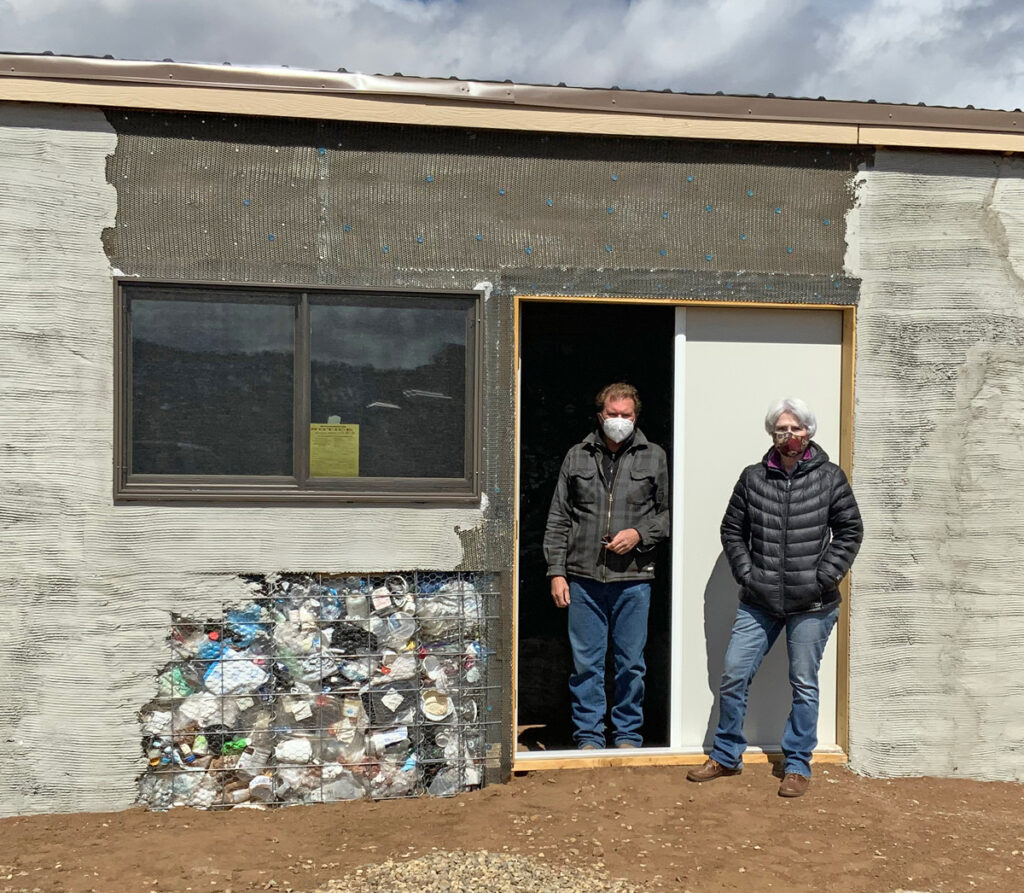Scientists have recently discovered microscopic plastic particles in the food we eat, the water we drink and, most disturbingly, even in human organs. Because the plastic items that we throw away can take as long as 500 years to decompose, those that sit in our landfills leach into our soil, streams, and eventually the ocean. In light of this, our local Repurposed Plastic Project (RPP) is an urgent and welcome idea.
Last year the RPP collected hundreds of bags of plastic that would have ended up in our land and water, and instead used them as building materials for a shed in Questa, as well as new seating areas and windbreak walls at the Questa Farmers’ Market site. Compressed plastic can be reused in walls, planters, benches—anything the builders or their future clients can imagine.
The RPP team includes founder and project coordinator Todd Wynward, builder and site supervisor Daniel “RYNO” Herrera, office manager Melanie Baca, builder and transport supervisor Randy Martinez, and architect Doug Eichelberger. This year RPP worked with Morris and Fran Reynolds of San Cristobal to build a shed that might just be the first permitted repurposed plastic project of its kind in northern New Mexico!
Measuring 10 by 20 feet, and sporting a double front window, the nearly completed Reynolds shed is the size of a small studio. It used more plastic trash than any other RPP project to date: over 1,000 bags. The building was large enough to require a building permit. Once it’s completed, later this year, it will have stucco inside and out, colored to match the owners’ home.
The goal of the Repurposed Plastic Project is not just to keep plastic from hurting ourselves and the environment, but also to aid local economic development. The RPP aims to eventually become a worker-owned cooperative, providing additional skill and training for local people to build. For now, however, it is housed under the non-profit Taos Initiative for Life Together (TiLT).
There was one problem with developing the RPP into an economic enterprise last year: the time it took to compress all that plastic to be used for wall fill. Using “people power” to physically stomp the plastic into a collapsed shape worked well at the Questa Farmers’ Market last summer with volunteers, interns, and the willing public: People were more than happy to take out their pandemic frustrations on the trash. But such people power is not readily available for all projects, nor is it efficient. Problem solved: with aid from the LOR Foundation, the RPP purchased a plastic baler. The baler can compress plastic trash into 30-lb bales the size of a few milk crates (42 x 22 x 16 inches). Much like hay is bound up, the plastic baler compresses and binds plastic that can then be stacked within wire fencing to build walls. The baler is now at the Questa RPP headquarters, ready to turn more plastic into building material.

What does this mean for you readers? Some of you running community projects may want to enlist RPP’s assistance on a community-centric project such as building a privacy wall at a school, a shed at a church, or benches in a plaza. Or you may want to tackle your own plastic masterpieces by purchasing bales from RPP.
The shed design is a load-bearing post and beam structure, with 16-inch infill plastic walls. The structure for the walls is a regular fence panel lined with chicken wire, all available at our local hardware store. All that plastic in the walls helps insulate much better than a prefab shed. To be sure—it’s not as warm in the winter as an adobe house, but you might get away with using one of these plastic filled sheds as a studio, provided you had a safe heat source in there with you. (Buildings 10 by 12 feet do not require a permit but larger buildings like the Reynolds’ shed do).
Other readers may just be interested in getting rid of their plastic trash in a way that keeps it out of our water and land, especially since Taos County stopped accepting plastic at the recycling center. For just $5/month, the RPP will accept up to two trash bags monthly of your clean plastic trash, and put it to good use. Drop-off locations are convenient, in both Taos and Questa. To become a member of the plastic project, go to https://www.repurposingplastictaos.com/
Author
-

Dr. Caroline Yezer is a cultural anthropologist (PhD Duke University 2007) who has taught anthropology curriculum at College of the Holy Cross and Clark University in Massachusetts.
View all posts


